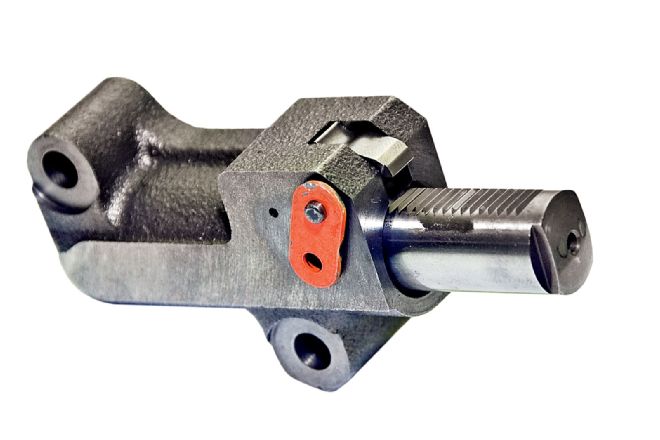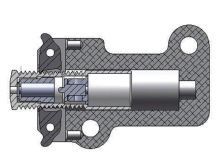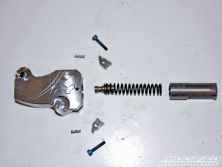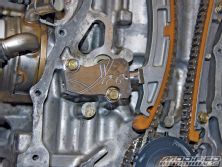Back in 2005 when I first swapped a K20A2 RSX Type-S engine into my EG Civic race car, one of the first mods I made to it was a set of Skunk2 Stage 1 camshafts. The idea was to keep the engine build fairly mild given the stress one-hour Touring Car races put on a motor. With these cams and the usual bolt-ons and a Hondata K-Pro for engine management, the otherwise stock K20 pumped out a very respectable 222 horses at the front wheels, enough to win all six Touring Car races I did that year.re.
 Honda's K-Series timing chain tensioner works very well on unmodified engines, but as I found out the hard way it doesn't always withstand the higher stresses placed upon it by aftermarket camshafts.
Honda's K-Series timing chain tensioner works very well on unmodified engines, but as I found out the hard way it doesn't always withstand the higher stresses placed upon it by aftermarket camshafts.
I also put quite a few extra race miles on the engine that year, competing in a few time attack events and going to a number of lapping days on top of the Touring Car races. Then, quite unexpectedly, the engine suffered a timing chain tensioner failure while testing some different intake systems on the dyno. As luck would have it, the tensioner failed during coastdown on the last dyno pull of the day, so we didn't even realize there was a problem until we were unable to restart the engine. At the time we were all scratching our heads, but after a little wrenching we discovered the timing chain had lost tension. A little Googling and it became clear that the OE timing chain tensioner was a "known problem" when using aftermarket camshafts and was in fact the culprit on my K20, but nobody had really investigated the reason behind these failures. Until now.
Hybrid Racing is a highly respected name in the Honda K-Series engine-swap world, owned and operated by a small group of Honda enthusiasts dedicated to making K-Series swaps as painless as possible. Hybrid has also been bringing some innovative new products to market for K-swappers, including its new shifter box that eliminates the need to cut the center tunnel in order to achieve OEM shifter placement and now the company's soon-to-be-released timing chain tensioner. Question is, how does H-R's tensioner address any inadequacies in the OEM tensioner, and what exactly are those inadequacies anyway?
Before getting into Hybrid's detective work on the OE tensioner and design of its stronger replacement unit, let's first take a closer look at what the timing chain tensioner is designed to do. The timing chain (or belt, in the case of older Honda engines) is what links the crankshaft to the camshafts, controlling valve timing in the process. If the chain were to lose tension and skip a few teeth on the crank or cam sprockets, valve timing would be thrown off, resulting in power loss and possible piston-to-valve contact. To prevent this scenario, Honda uses a hydraulically actuated tensioner that places a force on the timing chain guide to maintain proper chain tension. And since the chain can stretch both elastically (impermanently) and plastically (permanently), the tensioner is also designed to automatically adjust to variation in the chain's length.
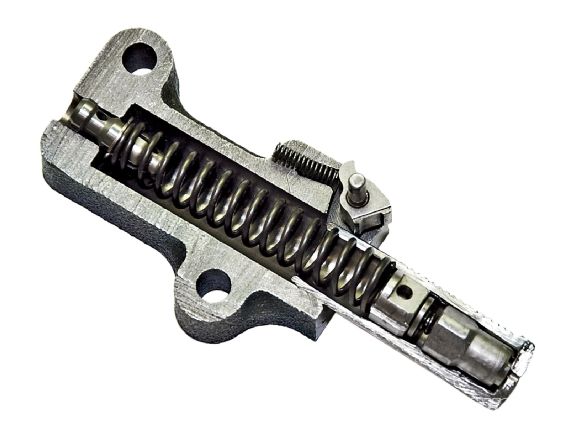 |
This cross-section of an OEM K-Series timing chain tensioner exposes its inner workings, including the failure-prone ratchet mechanism at the top with the small spring and the toothed piston, which houses the large spring and check/release valves that allow it to apply the appropriate force against the chain guide.
|
This cross-section of an OEM K-Series timing chain tensioner exposes its inner workings, including the failure-prone ratchet mechanism at the top with the small spring and the toothed piston, which houses the large spring and check/release valves that allow it to apply the appropriate force against the chain guide.
How does the tensioner adjust automatically? As you can see from the cross-section images, there's a simple one-way check valve assembly at the base of the large central spring and a release valve at the opposite end inside the tensioner piston. These valves allow oil to flow through the tensioner assembly, applying the appropriate force to the inner surface of the tensioner piston that in turn applies the appropriate force to the chain guide. You'll also notice a small ratcheting mechanism that interfaces with the toothed outer surface of the piston, which limits piston movement in and out to about a 0.25-inch, permitting the tensioner to take up any slack in the chain as it stretches. The large main spring at the center of the tensioner may look like a vital component, but it actually has a low spring rate and is just there to provide a bit of extra tension when oil pressure is low, such as during cranking and idle.
All in all, the factory K-Series tensioner is a clever piece of engineering, and to be fair to Honda there is nothing inherently wrong with its design when used as intended on a stock K-Series engine. According to Russ Garehan from Hybrid Racing, "We have not been able to find any cases of chain tensioner failure on a well maintained, unmodified engine. The tensioners are only failing when they are subjected to forces greater than they were designed for, such as those created by the more aggressive profile of aftermarket cams and higher spring rates of aftermarket valve springs. These higher loads wear out the teeth on the ratcheting mechanism used on the tensioner. If the teeth wear out enough, the piston can be pushed into the tensioner far enough to allow slack in the chain, which can result in skipped teeth on the cam gears and potential damage to the motor."
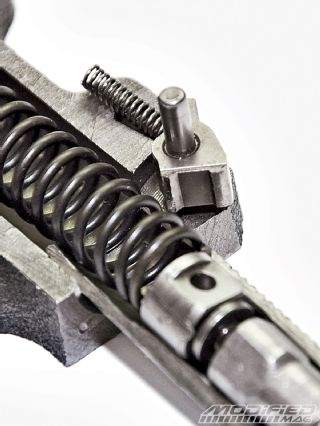 |
Hybrid Racing's Honda K-Series Timing Chain Tensioner - Good Tension, Bad Tension?
|
Hybrid Racing's Honda K-Series Timing Chain Tensioner - Good Tension, Bad Tension?
But that's not the only issue Hybrid Racing found with the OEM tensioner. According to Russ, "The only thing that prevents the piston from rotating or spinning in the tensioner is the groove in the chain guide that the tensioner piston fits into."
To address these two main concerns, Hybrid Racing first turned its attention to the design of the tensioner piston and the ratcheting mechanism. The piston was redesigned to make it press into the chain guide in order to minimize any rotation.
This prevents any misalignment of the teeth on the piston and ratcheting mechanism, which in theory should greatly reduce the wear on the teeth themselves. However, to further safeguard against teeth wear given the higher forces the tensioner must endure when aftermarket cams and valve springs are in use, Hybrid Racing added a second ratcheting mechanism to their tensioner, as shown in the design drawing.
The last and arguably most important part of the design stage for Hybrid Racing was the selection of materials for its tensioner and in particular the wear-prone ratcheting mechanism. The body of the tensioner is a special, wear resistant, super-tough stainless steel alloy and without giving away any trade secrets, Hybrid went with an extremely robust alloy for its ratcheting mechanisms, similar to those found in the ratcheting mechanisms on impact wrenches. "Developing this tensioner and sourcing the parts for it has been a tremendous undertaking. Every part has been custom manufactured to our specs. Even the springs it uses had to be custom-wound to suit our application."
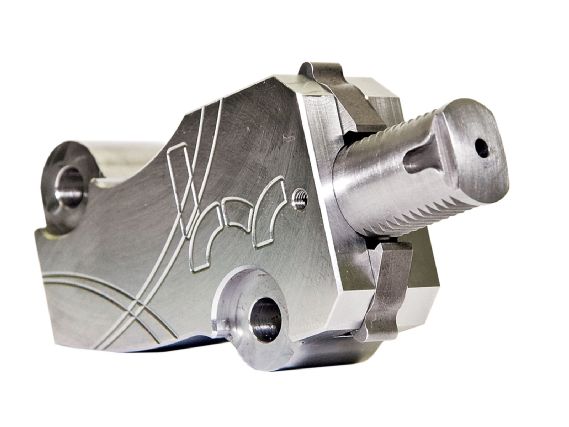 |
Hybrid Racing's tensioner not only looks pretty, it's made with tighter tolerances and from higher-grade materials than the OEM unit, providing the strength and durability required when running aggressive aftermarket camshafts.
|
Hybrid Racing's tensioner not only looks pretty, it's made with tighter tolerances and from higher-grade materials than the OEM unit, providing the strength and durability required when running aggressive aftermarket camshafts.
After more than a year of rigorous, abusive testing, Hybrid Racing has made its tensioner available to the public. Considering the tensioner's tighter tolerances, higher-grade materials and double ratcheting system, this certainly appears to be a product capable of putting all tensioner concerns to rest for anyone running a modified K-Series under their hood.

